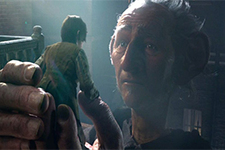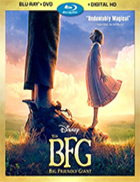The BFG
|  Although his work is often associated with children, Steven Spielberg has arguably directed only four “children’s films” in his nearly 50-year career: E.T. The Extra-Terrestrial (1982), Hook (1991), The Adventures of Tintin (2011), and now The BFG, an amiable, visually impressive fantasy based on the 1982 book by Roald Dahl. By “children’s film,” I mean specifically those that feature a child or notably youthful protagonist and are aimed specifically at a young audience (for this reason I don’t include the Indiana Jones films, even though they are arguably intended for a young audience, albeit one whose parents didn’t always appreciate all the melting faces, exploding heads, and torn-out hearts). The association of Spielberg with juvenilia has long dogged his career and made it impossible for some intractable critics to take him seriously as an artist, which is a shame because such a view is historically misguided and misuses a handful of Spielberg’s films—and not always his best—to characterize his entire body of work. The BFG is notable in this regard, as it is testament to Spielberg’s refusal to limit himself to any particular narrative. As a master filmmaker and populist storyteller whose career has seen numerous shifts, highs and lows, he has always remained relevant, and each of his new works is met with anticipation even if he hasn’t commanded true box office domination in some time (at least not as a director; his work as producer is something else entirely). Although he has clearly leaned toward more “serious” and politically minded historical films since the multi-Oscar-winning Schindler’s List back in 1993, he has not abandoned his gift for crafting stories that speak across generations, which is what made E.T. such a phenomenon 34 years ago. The BFG is not nearly the masterwork that E.T. is, despite the fact that both were written by the late Melissa Mathison, who Spielberg met on the set of Raiders of the Lost Ark when she was involved with Harrison Ford. But, it is still a resoundingly good fantasy, one that works its storybook magic both visually and emotionally. Despite opening in an orphanage, The BFG is a decidedly lighter work than E.T., as it is free of that film’s darker subtext of broken families, absent fathers, and bottled-up childhood anger. The pint-sized protagonist, a British orphan named Sophie (Ruby Barnhill), has no family and certainly feels alone, which Spielberg dramatizes in the opening sequence as she walks the orphanage halls alone at 3:00 a.m., the “Witching Hour,” but her background is not explored nor explained, thus keeping her unburdened of any specific traumas. She is, despite her inherent loneliness, feisty and assertive in a way that belies her age, which we see when she chastises a group of drunk men stumbling along the cobblestones outside the orphanage. Like E.T.’s Elliott, Sophie find connection with another lonely soul, in this case the BFG of the title, which stands for Big Friendly Giant (played by Mark Rylance, a recent Oscar winner for his memorably low-key turn in Spielberg’s A Bridge of Spies). Just as Spielberg initially depicted the lost extra-terrestrial as potentially menacing—or least unknown and therefore scary—BFG is first seen as a towering figure of hooded menace, shrouded in shadows as he moves through the streets of London in the dead of night, blowing little balls of shimmering light through a large horn into various windows. The balls of light are dreams, and when he realizes that Sophie has seen him, he snatches her in his hand and whisks her away to the Land of Giants, which is somewhere in the clouds above England. Initially threatening, BFG is revealed to be fundamentally benevolent, a gentle soul in an ambling five-story body who is actually the victim of the nine other giants who inhabit his land, all of whom are twice his size and bear delightfully nasty, self-explanatory names like Bonecruncher, Childchewer, Gizzardgulper, and Meatdripper (the two primary giants, Fleshlumpeater and Bloodbottler, are played by Jemaine Clement and Bill Hader). BFG, who has a sweet, lined face perched atop a lean neck and between two giant jug-ears that move like an elephant’s when he’s excited, is just as isolated as Sophie, so it is not surprising that they turn out to be kindred souls who look out for each other. BFG hides Sophie from the other giants, who want to eat her, while Sophie eventually helps BFG defend himself against them by enlisting the help of none other than the Queen of England (Penelope Wilton), who organizes a lunch meeting with BFG that is one of the film’s comic highlights and one of the most cleverly amusing sequences in any of Spielberg’s films. That it ends on what is essentially a giant fart joke would seem juvenile in the worst kind of way, but Spielberg pulls it off (he has always been a deft comedy director, and the perceived disaster of his wartime slapstick farce 1941 has probably been the only thing holding him back from making another outright comedy). BFG speaks in a poignantly mixed-up English that is replete with manufactured words and malapropisms, and one of the film’s sweetest moments is when Sophie, ever so proper in that very British kind of way, tells him that he speaks beautifully and he responds as if he’s seeing light for the first time. Given the subject matter, The BFG is a special-effects-heavy film, with numerous characters being complete digital creations based on motion-capture performances, including BFG himself. Working again with cinematographer Janusz Kaminski, who has shot all of his films since Schindler’s List, Spielberg abandons any sense of visual realism in favor of a painterly storybook aesthetic, which renders even seemingly straightforward shots of London at night magical. Because of the heavy digital presence in both characters and environments, including BFG’s wonderfully eclectic cave, the centerpiece of which is a room filled with jars contained glowing dreams and nightmares, the film has a visual sharpness and clarity that makes it look almost entirely animated, which is fitting to the material. Spielberg has long been renowned for his ability to work with child actors (something that the great French director François Truffaut recognized on the set of Close Encounters of the Third Kind, which led him to encourage Spielberg to make a film about children), and we can see it again in his work with Ruby Barnhill. As Sophie, she is cute without being cutsie, matching big, bright brown eyes with an expressive mouth (at times she looks a bit like Mara Wilson, who played the eponymous character in Danny DeVito’s 1996 adaptation of Dahl’s Matilda). Although she is quite capable of standing up for herself when needed (and for BFG), she has a fragile quality that makes her vulnerable, both physically and emotionally. Her character is relatively straightforward, which keeps The BFG more grounded in action and fantasy, rather than emotional subtext, which is a bit unfortunate because it keeps the film from plumbing the depths of childhood insecurities and fears that made E.T. and A.I. Artificial Intelligence (2001) such stunning, emotionally rending films. It is curious, though, that Spielberg and Mathison chose to alter the film’s ending, shifting away from Dahl’s vision of simple togetherness toward something more bittersweet. Many of Spielberg’s endings, even the ones that seem unambiguously upbeat, are much more complex than they are given credit for, and the notes on which The BFG end are perhaps its strongest, suggesting that kindred souls will always stay connected, no matter how far apart they may be.
Copyright © 2016 James Kendrick Thoughts? E-mail James Kendrick All images copyright © Walt Disney Home Entertainment | |||||||||||||||||||||||||||||||||||
Overall Rating: 

 (3)
(3)


